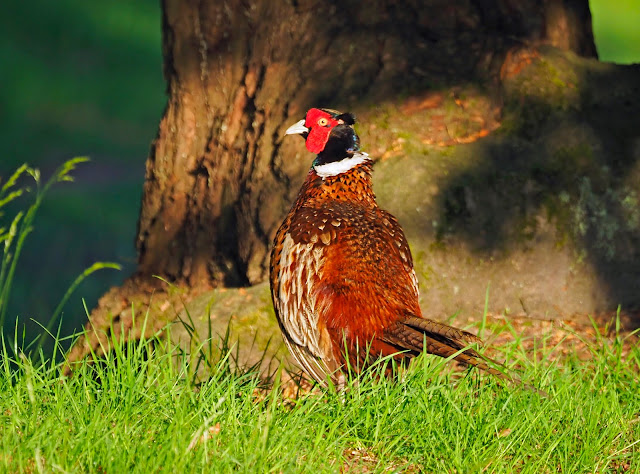From late afternoon 14th June to late afternoon on 16th June 2021, I had a rental car.
For the first full day I used it to get to and from a hospital appointment plus other things requiring a car but for the second full day I had a trip down to Ashdown Forest in the High Weald which makes up part of the counties of West Sussex, East Sussex, Kent and Surrey.
Ashdown Forest is an ancient area of open heathland with scattered trees occupying the highest sandy ridge-top of the High Weald Area of Outstanding Natural Beauty. The ecological importance of the heathlands is reflected by its designation as a Site of Special Scientific Interest, as a Special Protection Area for birds and as a Special Area of Conservation for its heathland habitats. It is part of the European Natura 2000 network as it hosts some of Europe's most threatened species and habitats.
Ashdown Forest is also famous as the setting for the Winnie-the-Pooh stories written by A. A. Milne who lived on the northern edge of the forest and took his son, Christopher Robin, walking there. The artist E. H. Shepard drew on the landscapes of the area as inspiration for many of the illustrations he provided for the Pooh books.
Old Lodge lies in the heart of Ashdown Forest and is a wide open landscape of heather, gorse and grassland plus stands of oak and birch trees and small plantations of Scots pine. Its character is subtly but noticeably different from true lowland heath due to its height above sea level and it is more reminiscent of some of the upland and moorland areas of western and northern Britain.
Broadwater Warren is a developing nature reserve and since 2007 the RSPB has reverted 100ha of conifer plantation back to lowland heathland. The majority of the large scale work has now been completed and heather is now well established across many of the heathland areas. As the heathland vegetation has returned the wildlife has returned too. The reserve now comprises a mosaic of open heathland and ancient woodland with woodland mires and forest ponds.
At Old Lodge, I added 2 species to my UK 2021 year list: Common Redstart (2 females) and Tree Pipit (1 singing male and 3 other singing males heard).
Other notable bird records included Woodlark (1 flying over), Dartford Warbler (1 singing male which I failed to see), Cuckoo (4 calling males which I failed to see), Willow Warbler (3 singing males plus c.15 other singing males heard), Common Whitethroat (7 singing males plus 3 other singing males heard), Blackcap (1 singing male plus 2 other singing males heard), Chiffchaff (1 singing male plus 3 other singing males heard), Stonechat (10), Goldcrest (1 plus many others heard), Coal Tit (1 plus many others heard), Nuthatch (2 ), Linnet (5), Skylark (1 heard singing), Green Woodpecker (1), Great Spotted Woodpecker (2 plus another heard calling), Mistle Thrush (1 carrying food to a presumed nest site), Greenfinch (1 male).
In addition to the above, a range of other common species resulted in a total list of 33 for my visit.
With regard to mammals, I recorded Fallow Deer (1), Grey Squirrel (2) and Rabbit (3) but unfortunately there was not a repeat of the sighting of Badgers as on my visit last year.
Finally, I had a lengthy view of a metallic blue-green male Beautiful Demoiselle at a small stream which definitely lived up to its name and provided excellent opportunities for photos.
Photo: male Beautiful Demoiselle
Photo: male Beautiful Demoiselle
Photo: male Beautiful Demoiselle
Photo: male Beautiful Demoiselle
Photo: male Beautiful Demoiselle
Photo: male Stonechat
Photo: male Stonechat
Photo: Nuthatch
Photo: Nuthatch
Photo: Nuthatch
Photo: Green Woodpecker
Photo: Green Woodpecker
Photo: Great Spotted Woodpecker
Photo: Pheasant
Photo: Grey Squirrel
Photo: Foxglove
Photo: Heath Spotted Orchid
After my walk around Old Lodge, I returned to Broadwater Warren. However, when I arrived at 9:45 a.m., the temperature was already 21°C and therefore I expected much less in the way of bird activity or bird song. This definitely proved to be the case but the increasing temperature (which had reached 29°C when I left the reserve) did encourage dragonflies and damselflies to fly.
Notable bird records included Tree Pipit (1), Willow Warbler (1 plus 2 singing males heard) Common Whitethroat (male and female at a nest site plus 2 singing males heard), Blackcap (3 singing males heard), Chiffchaff (6 singing males heard), Yellowhammer (2 singing males), Stonechat (1 male in display flight), Common Buzzard (pair soaring over the woodland).
The Decoy Pond produced sightings of Broad-bodied Chaser (1 male), Hairy Dragonfly (1 male), Beautiful Demoiselle (1 male), Common Blue and/or Azure Damselfly (at least 20).
I had 2 other notable sightings: a dead Common Shrew (the first that I have seen for many years) and a flyover WW2 Spitfire (presumably from Biggin Hill).
Both Old Lodge and Broadwater Warren are exceptionally wildlife-rich sites but I have definitely not seen the best of either yet. Next year, I intend to visit both sites in early May when bird activity and bird song will inevitably be far more intense.
Photo: male Broad-bodied Chaser
Photo: male Broad-bodied Chaser
Photo: male Broad-bodied Chaser
Photo: male Broad-bodied Chaser
Photo: male Broad-bodied Chaser
Photo: male Beautiful Demoiselle
Photo: male Azure Damsefly
Photo: male Azure Damsefly
After I returned my rental car, I walked home through the northern edge of my St. Nicholas Church local patch site and saw 2 male Common Blues, 2 Speckled Woods and a Chiffchaff.
💚🦆 🦉🦋🐝🦊🦡🌼 🌳💚
Stay safe, stay well, stay strong, stay connected with nature

































No comments:
Post a Comment
If you feel like commenting on my blog, you can contact me by completing the comment form below. I will respond to all comments and enquiries and constructive criticism will always be welcomed.